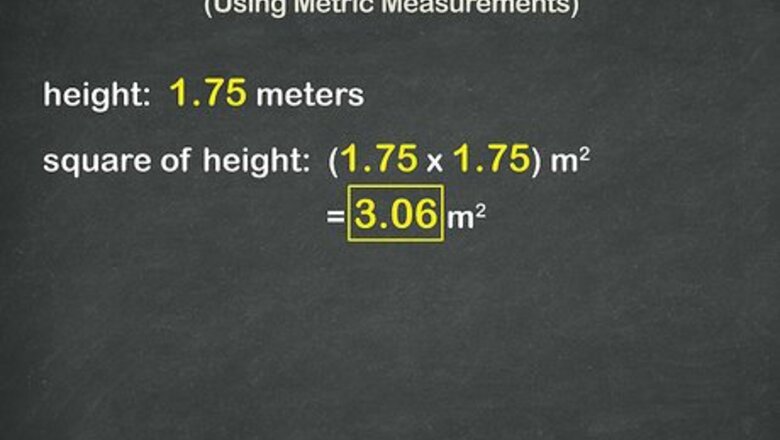
views
X
Trustworthy Source
Centers for Disease Control and Prevention
Main public health institute for the US, run by the Dept. of Health and Human Services
Go to source
There are different ways of calculating your BMI depending on the type of measurements you have taken. Make sure that you know your current height and weight before you get started and then try calculating your BMI.
See When Should You Try This? to learn more about when calculating your BMI might be a good course of action.
Using Metric Measurements

Take your height in meters and square the number. You will need to multiply your height in meters by itself first. For example, if you are 1.75 meters tall, then you would multiply 1.75 by 1.75 and get a result of approximately 3.06.

Divide your weight in kilograms by meters squared. Next, you will need to divide your weight in kilograms by your height in meters squared. For example, if your weight is 75 kilograms and your height in meters squared is 3.06, then you would divide 75 by 3.06 for an answer of 24.5 as your BMI. The full equation is kg/m in which kg is equal to your weight in kilograms and m is equal to your height in meters.
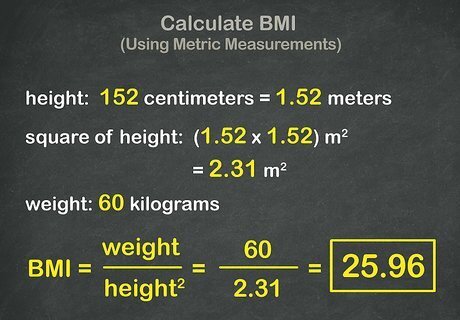
Use an extended equation if your height is in centimeters. You can still calculate your BMI if your height is in centimeters, but you will need to use a slightly different equation to do so. This equation is your weight in kilograms divided by your height in centimeters, then divided again by your height in centimeters, and then multiplied by 10,000. For example, if your weight in kilograms is 60 and your height in centimeters is 152, then you would divide 60 by 152, by 152 (60 / 152 / 152) for an answer of 0.002596. Multiply this number by 10,000 and you get 25.96 or about 26. The approximate BMI for this person would be 26. Another option is to simply change your height in centimeters to meters by moving the decimal two places to the left. For example, 152 centimeters equals 1.52 meters. Then, find your BMI by squaring your height in meters and then dividing your weight by your height in meters squared. For example, 1.52 multiplied by 1.52 equals 2.31. If you weigh 80 kilograms, then you would divide 80 by 2.31 and your result would be a BMI of 34.6.
Using Imperial Measurements
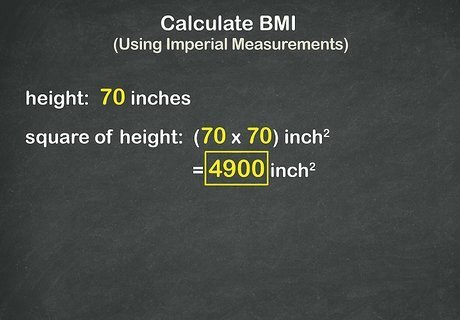
Square your height in inches. To square your height, multiply your height in inches by itself. For example, if you are 70 inches tall, then multiply 70 by 70. Your answer for this example would be 4,900.
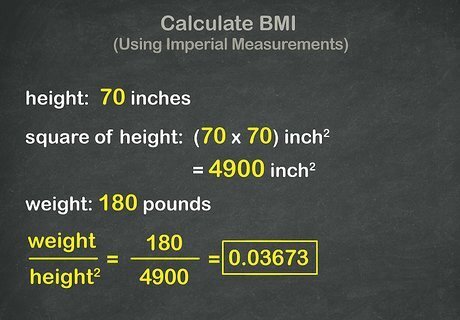
Divide weight by height. Next, you will need to divide your weight by your squared height. For example, if your weight in pounds is 180, then divide 180 by 4,900. You would get an answer of 0.03673. The equation is weight/height.
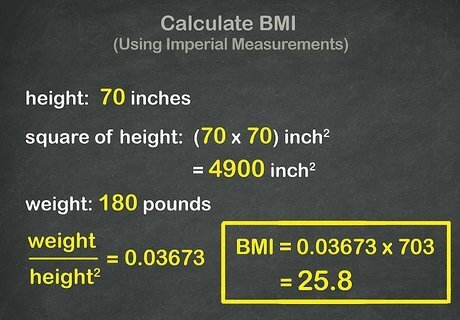
Multiply that answer by 703. To get your BMI, you will then need to multiply your last answer by 703. For example, 0.03673 multiplied by 703 equals 25.82, so your approximate BMI in this example would be 25.8.
When Should You Try This?
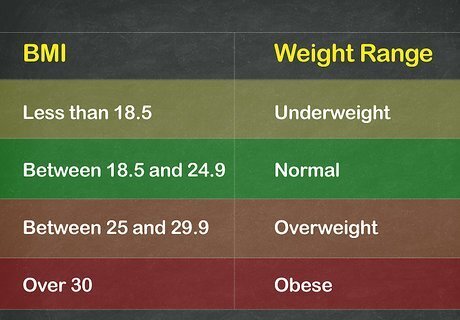
Calculate your BMI to determine if you are at a healthy weight. Your BMI is important because it can help you to determine if you are underweight, normal weight, overweight, or obese. A BMI below 18.5 means that you are underweight. A BMI of 18.6 to 24.9 is healthy. A BMI of 25 to 29.9 means that you are overweight. A BMI of 30 or greater indicates obesity.

Use your BMI to see if you are a candidate for bariatric surgery. In some situations, your BMI may need to be above a certain number if you want to have bariatric surgery. For example, to qualify for bariatric surgery in the UK, you would need to have a BMI of at least 35 if you do not have diabetes and a BMI of at least 30 if you do have diabetes.

Track changes in your BMI over time. You can also use your BMI to help you track changes in your weight over time. For example, if you want to chart your weight loss, then calculating your BMI on a regular basis might be helpful. Or, if you want to track growth in yourself or in a child, then calculating and tracking BMI is another way to do that.

Calculate BMI before considering more expensive and invasive options. A person with a BMI under 25 is considered to have a healthy body weight. However, if you have a higher than normal muscle percentage, your BMI might be higher. In that case, a BMI higher than 25 may not necessarily indicate that you are overweight. If you are muscled, consider getting skin fold testing to determine whether you have too much fat. Along with skin fold tests, underwater weighing, dual-energy x-ray absorptiometry (DXA) and bioelectrical impedance are some of the other options available for determining your body's fat content. Just keep in mind that these methods are more expensive and invasive than calculating BMI.

















Comments
0 comment